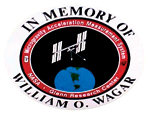
By Thomas Sutliff
When conducting physical science research in space, the smallest vibration or disturbance can disrupt sensitive experiments. Back in the 1990s we developed an instrument, the Space Acceleration Measurement System (SAMS) that flew on the shuttle to monitor the vibration environment — but it wasn’t very flexible. It could only measure vibrations for three users and only at fixed frequency ranges, and it had to be disassembled after each two-week mission to be refurbished, reconfigured, and readied for reuse.
Then the International Space Station came along. Our researchers needed a second-generation system, the SAMS-II, which would measure acceleration and vibrations for multiple payloads conducting experiments throughout the life of the station. Measurement requirements were all over the map with a variety of frequencies that needed measuring over a broad dynamic range, so it was essential to develop a robust system that would be flexible enough to accommodate all the particular users.
We came up with a concept using the Space Station’s Ethernet as the means to talk between multiple remote triaxial sensor systems and a remote controller box. Ultimately, our job was to acquire data within the existing constraints of the station and to quickly and effectively get that information to the scientists. In 1994 we had a $2.1-million budget and a four-year development schedule aimed at achieving these goals. Technical risks were few and primarily resulted from uncertainty of ISS capabilities. At that point, we didn’t worry about a thing programmatically; our cup runneth over.
The Glass is Now…
Our fate, however, was tied to the fate of the Space Station. We were working on a system that would conduct experiments inside a structure that was being designed and built at the same time as our system. The Space Station began to go over budget, and they passed along the cost challenges to all the projects connected to them. By the end of a budget slashing in 1996, we had taken about $1.5 million in cuts. That left us with about $600,000 to do our job. No amount of magic was going to let us develop our full system — or at least a system that would meet the needs of all our various customers — for the budget we had left.
As project manager, I had to deliver the bad news to the project team, but I didn’t want them to see this as the end. I said to them, “You know what our project looked like yesterday. Here is what it looks like today.” I held up our project logo and tore it in half to hammer the message home. True, what we had left was smaller; it couldn’t meet all the original mission requirements — but we still had a project that was very much alive. And the good news: our customers still needed our sensors. We still had a job to do, and we needed to focus on what was still viable. We needed to stay excited about our project, even though its scope had significantly changed. It was going to take creativity and enthusiasm to work with what we had, and I planned to make the most of it. “The glass is not half empty,” I told them. “It is absolutely half full.”
Our most immediate problem was that we already had a signed agreement to deliver the first sensor subsystem to one of our customers. For now, we knew we couldn’t serve all of our intended users, but we could at least figure out a way to meet the needs of our initial customer. The rest would have to wait.
It’s All About Perspective
The project team’s response to this challenge taught me how resilient people and projects can be when you give them the chance. We took a look at our entire system. We said, “Okay, together we’ve got to come up with a new strategy.” We already had a system design for the control unit and distributed sensors at multiple locations, but our original $2.1-million budget was needed to create the control unit for the sensors. Now we had no money for that, and we already had the first sensor delivery agreement. We asked ourselves, “How are we going to provide the researchers with the acceleration data they need without our onboard control system?”
As a team, we came up with a bright idea. The vehicle design already had laptops in the Space Station that they were using as vehicle systems controllers. If we used an extra one of these existing laptops as our onboard control unit, we could cut the cost of developing hardware. And since it was designed for flight aboard the Space Station, we didn’t have to worry about the cost of design, development, or testing to meet their requirements with a new system; it would already be flight-qualified by the International Space Station program.
There was still the issue of where to put the laptop. We weren’t the Space Station’s priority, and they weren’t going to let us just put it anywhere. So, once again, the team came up with the idea of adapting one of the Station’s existing International Sub-rack Interface Standard (ISIS) drawers to house the computer. The ISIS drawer is a standard configuration with power and data connections in the back. If we used a standard drawer, our control unit laptop would be tucked inside and out of the way. And since the drawer had been designed to the Space Station’s requirements as well, we again wouldn’t have to do any additional structural or thermal modeling, or worry about any other new payload constraints.
Ultimately, we made an agreement with the program that they would authorize the project in two phases. The laptop control unit wouldn’t give us as much performance as we would’ve had on our original system, but it would give us enough to support our initial users. We knew we had to be satisfied with a temporary solution or none at all, so we planned an eventual upgrade to the control unit with a second iteration of the project. In the end, this temporary solution allowed us to serve our initial researchers as well as other Space Station projects.
And Some to Spare
In April 2001, we successfully launched the modified SAMS-II aboard STS-100. After the Station crew unpacked their bags, configured hardware brought aboard, and got things going, we acquired our first data and down-linked it successfully. Since then, we’ve accumulated over 16,000 hours of operation. We had the system up and running three years ahead of when we would have if we’d waited for the rest of our budget to be reinstated.
As it turned out, there was a point when the control unit laptop failed — not our custom software and not our unique power system. As a result of the ‘built-in’ spares on the Space Station, we were able to get another laptop allocated to us, put our hard drive into the new laptop, and get the system back up and running. The paperwork required to do this — and the approval process for it — was much harder than getting the crew and hardware together to make it happen. The loop was closed. We had provided a versatile, maintainable measurement system. It was supporting multiple users, some of whom weren’t involved in the initial requirements development phase. And we did it in spite of technical and programmatic obstacles.
I think that this comes back to the general attitude that we had about the project. As a project manager, you’ve got to remember to give a little bit of positive reinforcement along the way. Sometimes you have to keep reminding your team that the glass is half full, or at least there is enough in the glass to keep going.There are always going to be cracks forming — but if you hold it tightly, you may find you can slow those leaks enough to make it to the finish line before the glass empties. Many times, what you need to do is believe in the positive — and then go make it happen. This time we were able to find a smaller glass. That’s what project management is all about.
Lessons
- Leadership requires realism coupled with optimism.
- Constrained resources are often the best way to provoke innovative solutions.
Question
How can you artificially create a situation in which resources are frequently constrained for the purpose of triggering such innovation?
AN EXPERIMENT’S LEGACY
 As with many small-scale projects within NASA, there is invariably a driving force behind the scenes focused on achieving the project’s technical and operational objectives.
As with many small-scale projects within NASA, there is invariably a driving force behind the scenes focused on achieving the project’s technical and operational objectives.
The Microgravity Acceleration Measurement System or MAMS is no exception to this rule; our friend Bill Wagar was that driving force behind the MAMS experiment. In accomplishing its important objectives of characterizing the sources of microgravity disturbances on the International Space Station, MAMS has currently accumulated over 1,100 days and over 25,000 hours of operation on the ISS since its launch on STS-100 in April 2001.
Unfortunately, Bill passed away during the processing of the MAMS experiment and was unable to witness its activation and continued success. As a tribute to Bill and his dedication to MAMS, a commemorative sticker was designed and installed on the MAMS front panel following MAMS final processing at the Kennedy Space Center. Each time we are fortunate enough to view a video clip of the Destiny Module and catch a glimpse of the commemorative logo, we are reminded of Bill and how fragile life here on Earth can be. Increment 2 crew member Susan Helms summarized our feelings during a dedication offered on board the ISS in saying, “I myself would like to add my wishes to his family, my regrets that Bill has moved on to a better place, but also my congratulations to the work he did leave behind, because he was obviously extremely successful.”
Search by lesson to find more on:
- Leadership
- Risk










